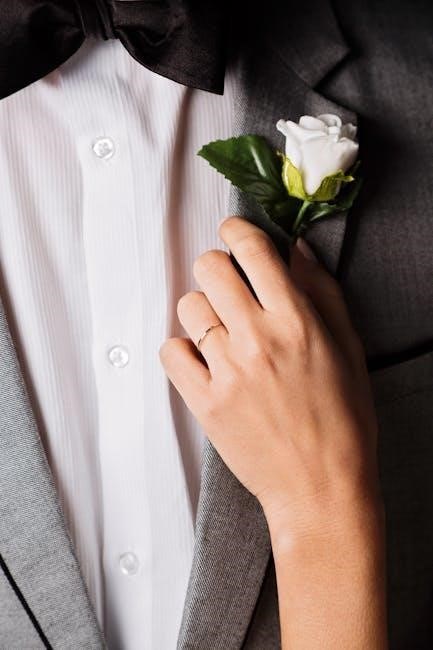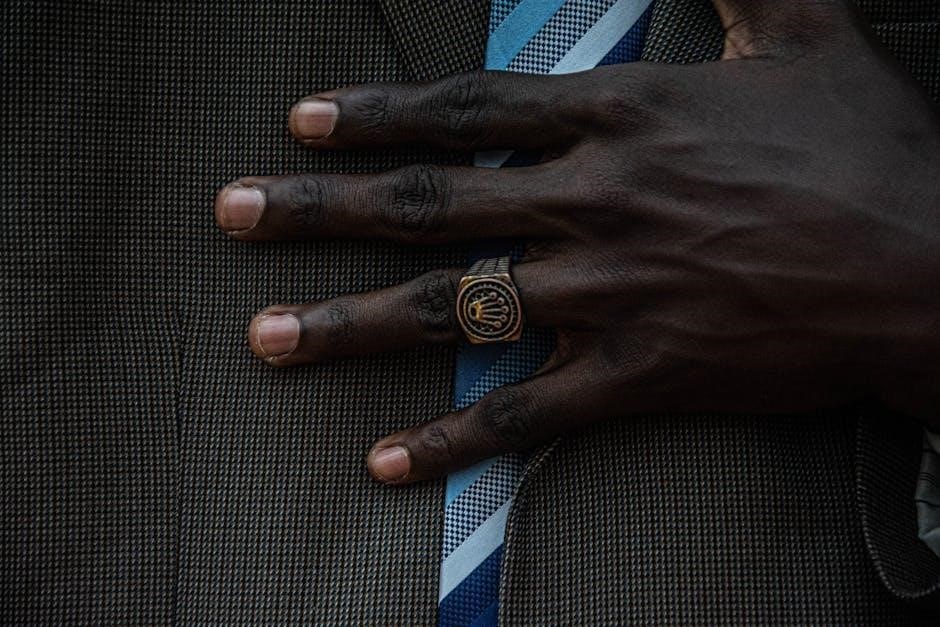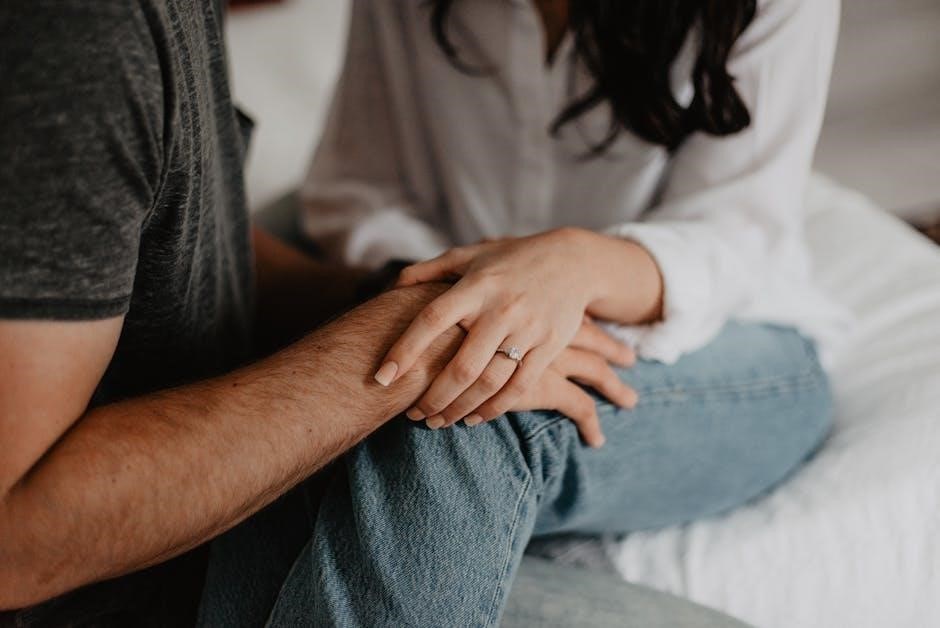
men’s ring size guide
Discover the essential guide to men’s ring sizes, ensuring a perfect fit. Learn how to measure accurately using tools like ring sizers, string, or existing rings for precision.
1.1 Importance of Finding the Right Ring Size

Finding the right ring size is crucial for comfort and appearance. A ring that’s too tight can cause discomfort, while one that’s too loose may slip off. Proper fit ensures the ring stays secure without restricting movement. Measuring accurately prevents costly resizing and ensures the ring looks proportional to the finger. Incorrect sizing can lead to constant adjustments, affecting the overall satisfaction of wearing the ring. A well-fitting ring enhances the wearer’s confidence and complements their style. Whether for everyday wear or a special occasion, the right size guarantees a perfect balance of functionality and aesthetics.
1.2 Brief Overview of Men’s Ring Sizes
Men’s ring sizes typically range from 4 to 20, with the average size falling between 8 and 12. The sizes follow a numerical system, where each size represents a specific circumference measurement. Half sizes are also available to ensure a precise fit. Proper sizing is essential for comfort and appearance, as a ring that fits well enhances both style and functionality. Finger shape, knuckle size, and personal preference influence the ideal fit, making accurate measurement crucial for satisfaction. Understanding the sizing system helps in selecting a ring that complements the wearer’s hand perfectly.

How to Measure Ring Size at Home
Measure your ring size at home using simple tools like a ring sizer, string, or an existing ring. These methods provide quick and accurate results for the perfect fit.

2.1 Using a Ring Sizer Tool
A ring sizer tool is the most accurate way to determine your ring size at home. This adjustable tool, often a slender cone with marked sizes, allows you to slide it onto your finger until it fits comfortably. It provides precise measurements, typically within a quarter of a size. For the best results, ensure your finger is at a neutral temperature, as swelling can affect fit. Many jewelers offer ring sizers, or you can purchase one online. This method is highly reliable and ensures a perfect fit for your ring.
2.2 The String Method for Measuring Finger Size
The string method is a simple and effective way to measure finger size at home. Wrap a flexible string or strip of paper around the base of your finger, ensuring it’s not too tight or loose. Mark the point where the string overlaps, then measure the length with a ruler. Compare this measurement to a standard ring size chart to determine your size. For accuracy, measure at room temperature, as fingers can swell slightly during the day. This method is handy for those without access to a ring sizer tool, though it may require some patience to achieve precise results.
2.3 Measuring an Existing Ring
Measuring an existing ring is a straightforward method to determine size accurately. Place the ring on a ruler or use a ring size chart to measure its internal diameter. Ensure the ring lies flat and align the edge with the chart’s markings. This method works best with rings that fit the intended finger comfortably. For precision, measure the diameter in millimeters and compare it to a standard ring size chart. This approach avoids guessing and provides a reliable size, especially for those familiar with their current ring fit. It’s a practical solution for determining size without additional tools or complex measurements.
2.4 How to Use a Ring Size Chart
Using a ring size chart is a reliable method to determine your size accurately. Start by printing the chart on paper, ensuring the scale is correct. Place a ring you own over the circles on the chart, aligning it with the inner edge. Match the diameter or circumference to the corresponding size. For the best fit, measure at room temperature, as fingers can swell slightly in heat. Compare multiple rings if possible to confirm consistency. This visual guide provides a clear reference, helping you identify your size without guessing. It’s a practical tool for those without access to professional sizing tools.
Understanding Men’s Ring Size Charts
Understanding men’s ring size charts is crucial for the perfect fit. Men’s sizes typically range from 3 to 14, with the average being 8-10. Each size corresponds to specific circumference measurements, ensuring accuracy. Remember, ring width impacts fit; wider rings may require a larger size for comfort.
3.1 Standard US Ring Size Chart for Men
The standard US ring size chart for men typically ranges from size 3 to 14. Each size corresponds to the inside circumference of the ring in millimeters. For men, the average ring size falls between 8 and 10. To determine the correct size, measure the inside diameter of a well-fitting ring or use a ring sizer tool. Accurate measurement ensures comfort and proper fit. Factors like finger shape and knuckle size can influence the fit, so it’s important to consider these when selecting a size. Refer to a detailed ring size chart or consult a jeweler for precise sizing.
3.2 International Ring Size Conversion
International ring size conversion is crucial for global compatibility. The US system differs from European, Japanese, and other systems. Men’s sizes in the US range from 3-14, while Europe uses 40-70, and Japan from 1-25. Conversion charts provide precise correlations, ensuring correct fit worldwide. For instance, a US size 8 equals a European size 46. Accurate conversion avoids resizing hassles. Utilize conversion guides available online or consult jewelers to match sizes across regions, ensuring the perfect fit regardless of the country. This simplifies shopping internationally and maintains consistency across borders for men’s rings. Proper conversion ensures comfort and style globally.
3.3 How to Read a Ring Size Chart
Reading a ring size chart is straightforward once you understand the layout. Most charts display ring sizes horizontally, with corresponding measurements like circumference (mm) and diameter (mm) vertically. Match your measured finger size to the chart to find the correct size. For example, if your finger measures 58mm in circumference, you’ll find the corresponding size on the chart. Key points to note include understanding the difference between inside diameter and circumference measurements. Always double-check your measurements to ensure accuracy. Some charts also include international size conversions, making it easier to compare across regions. This ensures a precise fit tailored to your needs. Properly aligning your measurements guarantees comfort and style. Additionally, consider the ring’s width, as thicker bands may require a slightly larger size for comfort. Finally, lifestyle factors like activity levels can influence the ideal fit, so choose a size that balances snugness and ease of movement. By carefully interpreting the chart, you can confidently select the perfect size. Always refer to the chart specific to your region or jeweler for consistency. This method ensures accuracy and avoids the need for resizing. Remember, proper fit is essential for both comfort and functionality. Using the chart effectively guarantees satisfaction with your ring purchase. Trust the measurements and enjoy a seamless fit. Your ring should neither be too tight nor too loose, and the chart guides you to achieve this balance.

Factors Affecting Ring Size
Factors like finger shape, knuckle size, weight, and temperature significantly impact ring fit. These elements ensure the ring is neither too tight nor too loose, providing comfort and style.
4.1 Finger Shape and Size Variations
Finger shape and size play a crucial role in determining the perfect ring fit; Men with slender fingers may require a slightly smaller size, while those with thicker fingers or larger knuckles may need a larger size to ensure comfort. Additionally, temperature can cause fingers to swell or shrink, affecting the fit. Understanding these variations helps in selecting a ring that sits comfortably without being too tight or loose. Proper measurement accounts for these factors, ensuring the ring is tailored to individual finger characteristics for optimal wearability and style.
4;2 Knuckle Size and Its Impact on Fit
Knuckle size significantly influences ring fit, as larger knuckles require a slightly bigger size to ensure the ring slides on and off comfortably. If the knuckle is notably larger than the finger, the ring must accommodate this to prevent discomfort or difficulty in removal. Measuring both the finger and knuckle ensures a balanced fit. Additionally, ring width plays a role; wider rings may feel tighter on fingers with prominent knuckles. Considering knuckle size helps in selecting a ring that is both comfortable and secure, avoiding the need for constant adjustments or potential resizing.
4.3 Weight and Muscle Distribution
Weight and muscle distribution can affect ring fit, as fluctuations in body weight may cause fingers to swell or shrink. Muscular individuals or those with larger hands may require a slightly larger size to accommodate thicker fingers. Similarly, weight changes can lead to variations in finger circumference, making it essential to consider current activity levels and muscle tone when measuring. For those who frequently work out, muscle growth on the hand or fingers may necessitate a reevaluation of ring size. Measuring at the end of the day, when fingers are at their largest, provides the most accurate fit. Professional sizing is recommended for precision.
4.4 Temperature and How It Affects Fit
Temperature plays a significant role in ring fit, as fingers can swell in heat and shrink in cold. During warmer months, increased blood flow causes fingers to expand, potentially making a ring feel tight. Conversely, in colder conditions, fingers contract, which may result in a looser fit. To ensure accuracy, measure your ring size at a neutral temperature, ideally in the morning or midday, when your body is at its natural state. This ensures the ring remains comfortable across varying conditions, preventing discomfort due to seasonal changes.
Additionally, avoid measuring after intense physical activity or in extreme weather, as these can temporarily alter finger size. For the best fit, consider the average temperature conditions in which the ring will be worn most often.

Tips for Choosing the Right Ring Size

Try rings before buying, consider lifestyle needs, and seek professional sizing guidance. Avoid guessing sizes and opt for stackable options if unsure. Ensure comfort in all conditions.
5.1 Trying Rings Before Buying
Trying rings before buying is a crucial step in ensuring the perfect fit and style. Visit a jewelry store to test different sizes and designs. This allows you to assess comfort, how the ring sits on your finger, and its overall appearance. Use in-store sizing tools or ask for professional guidance to confirm your size. This hands-on approach helps avoid resizing hassles later. Online ring sizers can also assist, but in-person trials provide the most accurate experience. Prioritize this step to ensure your ring feels and looks its best on your hand.
5.2 Considering Stackable Rings
When considering stackable rings, it’s important to think about how multiple rings will fit together. Each ring’s width can affect the overall comfort and appearance. Measure each finger separately if planning to stack rings on different fingers. Consider the total width of the rings to ensure they don’t feel too tight or bulky. Start with a base ring and add complementary styles, ensuring each piece enhances the overall look. Stackable rings offer versatility, but proper sizing is key to maintaining comfort and style. Use a ring size chart to guide your selection and ensure a seamless fit for every ring in your stack.

5.3 Understanding Ring Resizing Options
Understanding ring resizing options is crucial for ensuring a lifelong fit. Most rings can be resized, but the ease and cost vary. Simple bands are often easier to resize, while intricate designs may require more effort. Resizing involves stretching or compressing the metal, which can weaken the structure slightly. Some rings, like those with gemstones, may not be resizable. It’s essential to consider potential resizing needs before purchasing. Many jewelers offer resizing services, but it’s wise to confirm beforehand. Proper fit is key, and resizing ensures your ring remains comfortable and secure for years to come.
5.4 Lifestyle Considerations for Ring Fit
Lifestyle factors significantly impact ring fit. For active individuals, a snug fit is recommended to prevent shifting during activities. Those working with tools or in manual labor may prefer a slightly looser fit to avoid discomfort. Climate also plays a role, as temperature changes can cause fingers to swell or shrink. Consider your daily routines and environments when choosing a size. Additionally, frequent travelers or those with fluctuating weight should opt for a ring that accommodates minor size variations. Ensuring comfort and practicality ensures long-term satisfaction with your ring choice.
Determining Someone Else’s Ring Size Secretly
Discover how to secretly determine someone’s ring size by borrowing their ring, comparing to common objects, or discreetly measuring their finger. Ensure accuracy and avoid detection.

6.1 Borrowing a Ring They Already Own
Borrowing a ring they already own is one of the most effective ways to determine their size discreetly. If they wear a ring on their ring finger, this method is ideal. Once you have the ring, measure its internal diameter using a ruler or compare it to a ring size chart. For accuracy, ensure the ring fits their finger comfortably. This method provides a precise measurement without raising suspicion. To avoid detection, borrow the ring when they are distracted or not paying attention. Measure quickly and return it to its original place to keep your plan secret.
6.2 Comparing to Common Objects
Comparing their finger to common objects can help estimate their ring size discreetly. For instance, measure the circumference of their finger using a string or a flexible object like a strip of paper. Wrap it around the finger, mark the overlap point, and compare it to a ring size chart. Alternatively, use everyday items like a coin or a key to gauge the size. This method is quick and subtle, allowing you to determine an approximate size without them noticing. Ensure the object fits snugly, similar to how a ring would, for the most accurate comparison.
6.3 Using a Bar of Soap for Measurement
A bar of soap can be a clever tool for measuring finger size discreetly. Warm the soap slightly to make it malleable, then press the ring firmly into the soap, creating a clear impression. Measure the diameter of the impression using a ruler or caliper to determine the ring’s circumference. Compare this measurement to a standard ring size chart to find the corresponding size. This method is subtle and effective, allowing you to gather the necessary information without raising suspicion. Ensure the impression is clear for accurate results, and consider double-checking the size if possible.

6.4 Discreetly Measuring Their Finger
To measure someone’s finger discreetly, consider using a string or a strip of paper. Wrap it around their finger, mark the point where it overlaps, and measure the length with a ruler. Compare this to a ring size chart for accuracy. Alternatively, engage them casually by trying on rings together or using a paper strip as a playful activity. Ensure the process feels natural and relaxed, avoiding suspicion. This method allows you to gather the necessary information subtly while maintaining a lighthearted interaction. Precision is key, so double-check the measurement if possible.
Common Mistakes to Avoid
Guessing sizes without measurement, ignoring proper fit, and not considering ring width are common errors. Overlooking resizing options and assuming size consistency across brands also lead to poor fits.
7.1 Guessing the Size Without Measurement
Guessing a ring size without proper measurement is a common mistake that often leads to an ill-fitting ring. This approach can result in a ring that is too tight or too loose, causing discomfort or requiring costly resizing. Sizing varies between brands and styles, so assumptions based on general estimates are unreliable. To ensure accuracy, use a ring sizer tool, the string method, or measure an existing ring. Remember, precise measurement is crucial for comfort and proper fit, so avoid relying on guesswork and utilize the tools available to determine your exact size.
7.2 Ignoring the Importance of Proper Fit
Ignoring the importance of proper fit is a critical mistake when selecting a ring. A ring that is too tight can cause discomfort and restrict blood flow, while one that is too loose may slip off or get damaged. Proper fit ensures both comfort and functionality, especially for everyday wear. Many men overlook the significance of precise sizing, leading to dissatisfaction with their purchase. Accurate measurement is essential to avoid these issues, as resizing can be costly and not always possible. Prioritize fit to enjoy a ring that feels great and lasts for years to come.
7.3 Not Considering the Ring’s Width
Overlooking the ring’s width is another common mistake that can affect comfort and functionality. Wider rings may require a slightly larger size for a comfortable fit, while narrower rings can fit more snugly. Ignoring this detail can lead to a ring that feels too tight or too loose, compromising both aesthetics and practicality. Additionally, the width impacts durability, with thicker bands often being more robust. Always consider the ring’s width when selecting a size to ensure optimal comfort and a proper fit tailored to your lifestyle and preferences.
7.4 Overlooking Resizing Options
Many individuals mistakenly believe that a ring’s size is final, ignoring the possibility of resizing. Most rings can be adjusted to fit better, but some materials or designs may limit this option. Failing to consider resizing can lead to discomfort or dissatisfaction with the fit. Always inquire about resizing possibilities when purchasing, as this can provide flexibility if the initial size isn’t perfect. Additionally, understanding the resizing process can alleviate concerns about long-term wearability, ensuring the ring remains comfortable and secure for years to come.
Selecting the right ring size is crucial for comfort and style. This guide provides essential tips and methods to ensure a perfect fit, enhancing your ring-wearing experience.
8.1 Recap of Key Points
8.2 Final Tips for the Perfect Fit
For a flawless fit, prioritize accurate measurements using tools like ring sizers or the string method. Always consider knuckle size, as it impacts how easily the ring slides on. If unsure, opt for a slightly looser fit to ensure comfort. Trying rings in person is ideal, but if shopping online, use detailed size charts and reviews. Consider stackable options for versatility and ensure the ring’s width complements your finger shape. Lifestyle matters too—choose durable materials if actively wearing the ring. Finally, don’t hesitate to consult a jeweler for resizing or adjustments to achieve the ultimate comfort and style.